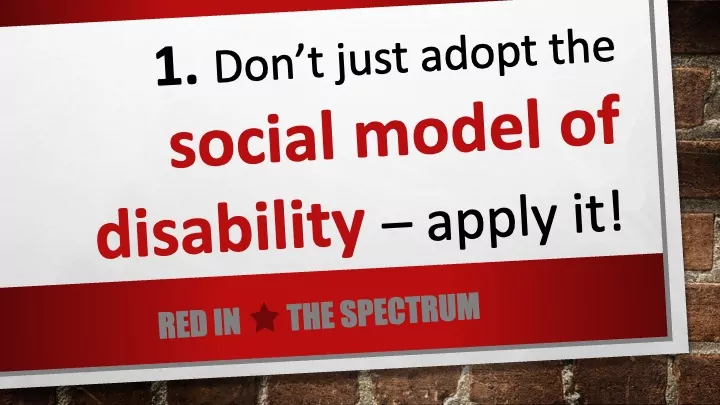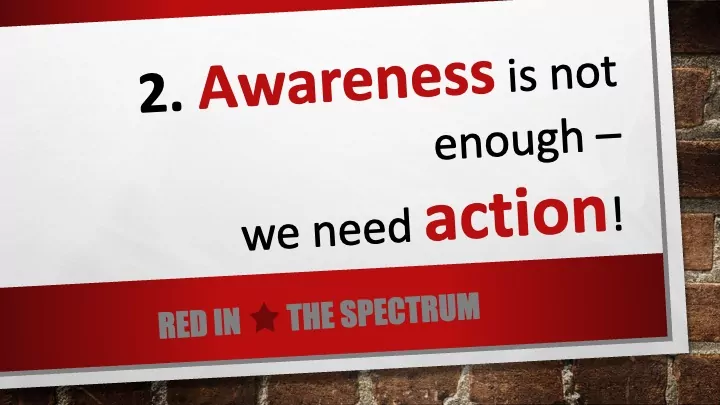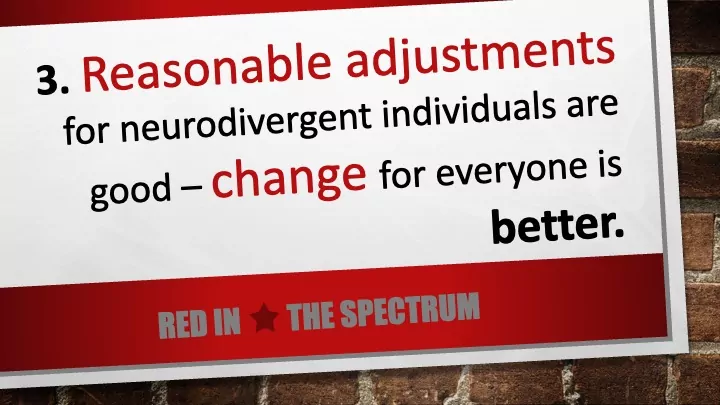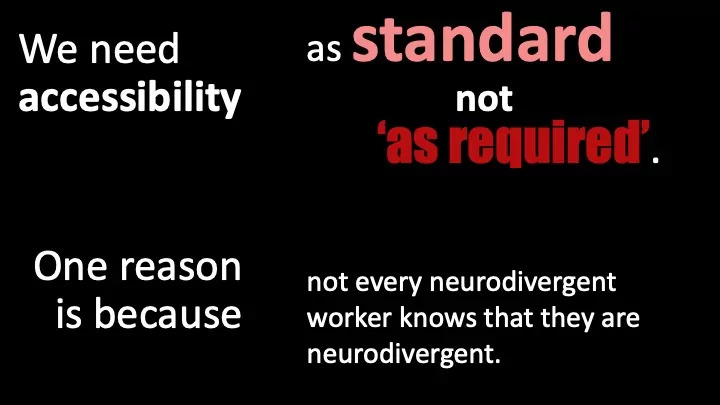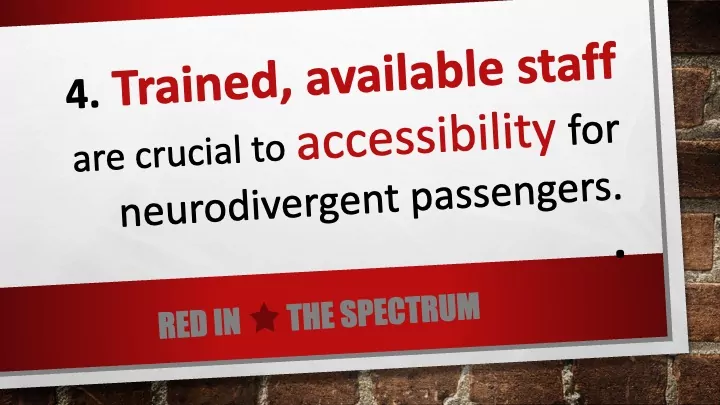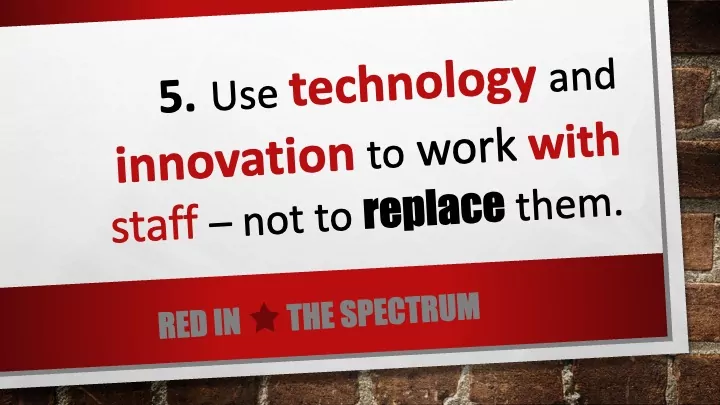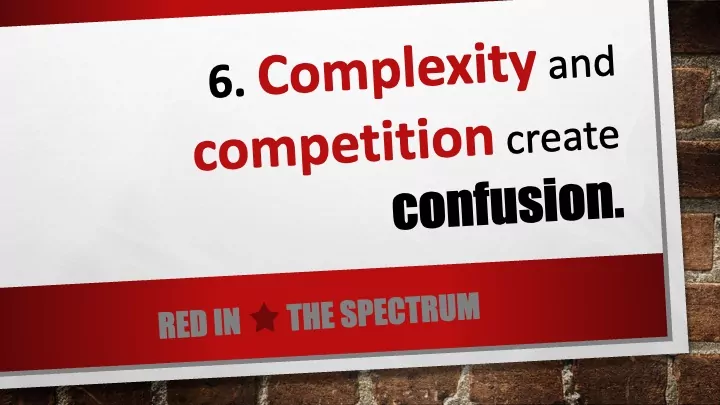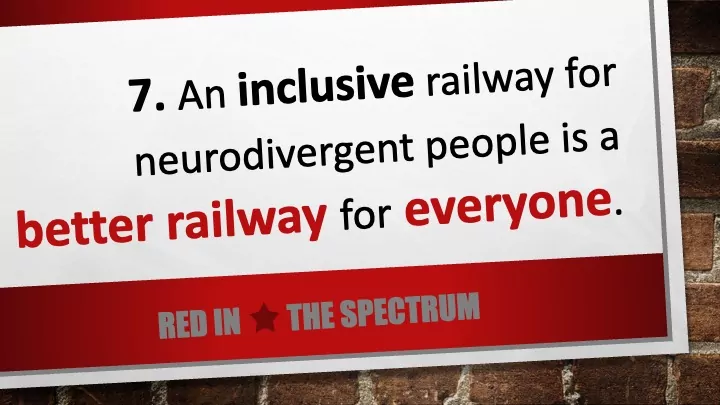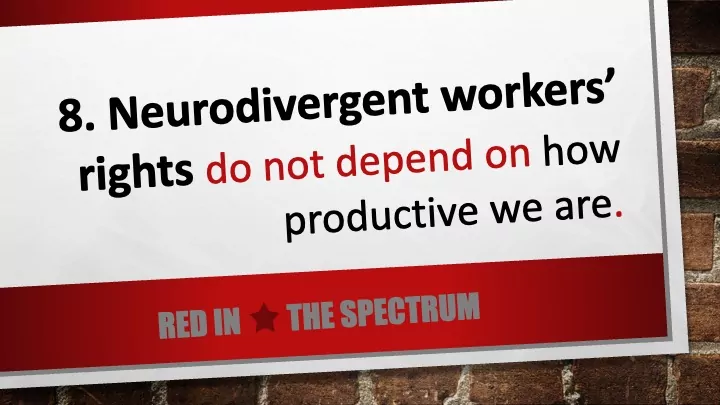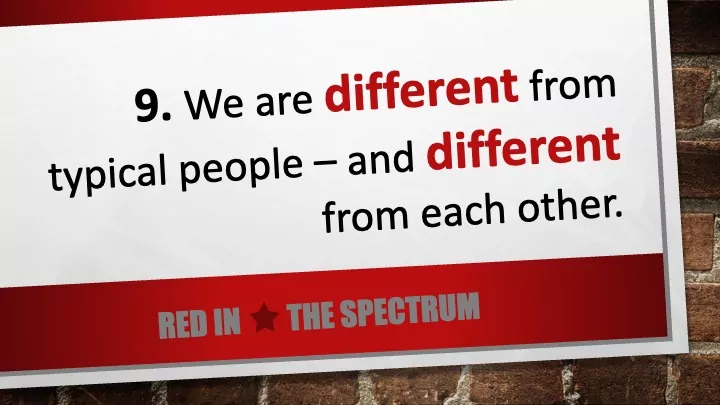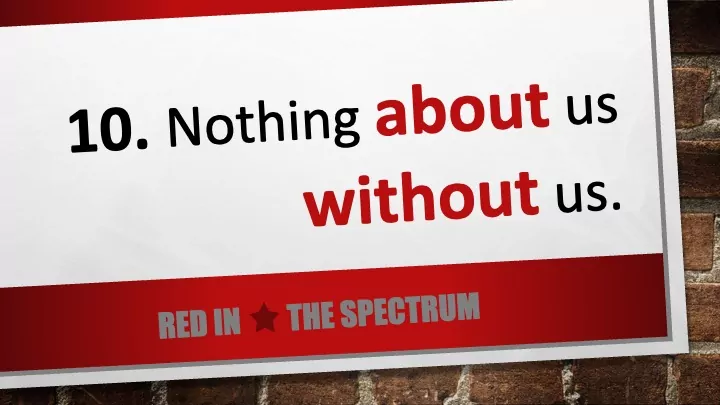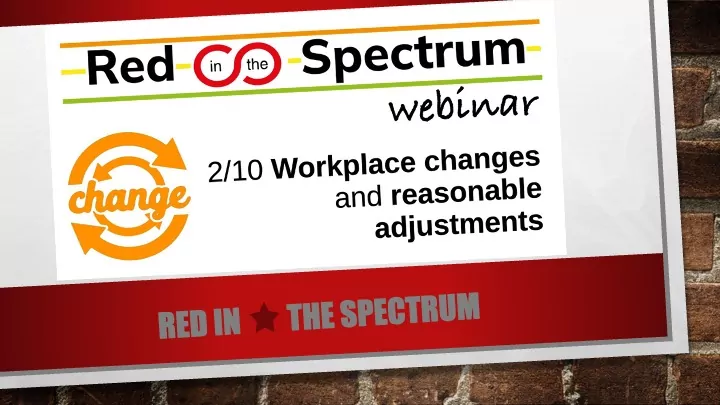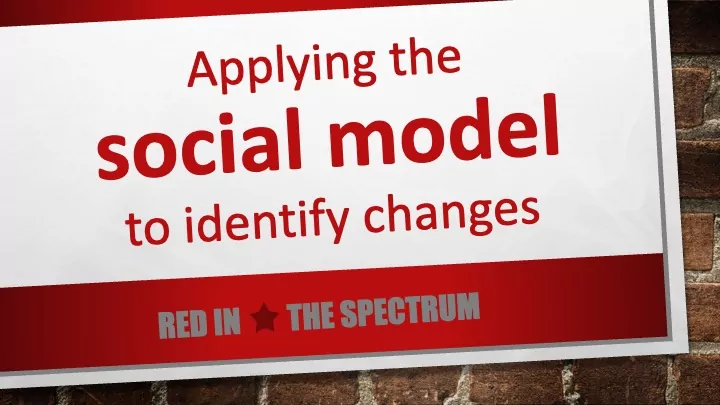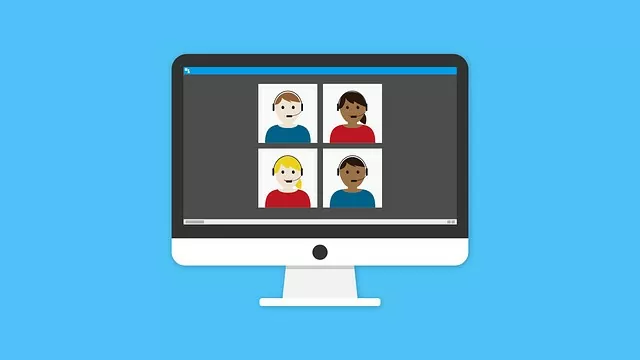Neurodiversity in rail: 10 challenges to the industry
Red in the Spectrum’s Janine Booth was the keynote speaker at the 2024 Neurodiversity in Rail conference held at Birmingham University on 21 May.
Janine is a leading authority on neurodiversity in rail, with a track record including:
- 25+ years as a London Underground station supervisor
- founder / trainer at Red in the Spectrum
- railway content writer
- autistic / ADHD / specific learning difficulties of a dyslexic type
This is what she said …
Neurodiversity in rail: Ten challenges to the railway industry
- Don’t just adopt the social model of disability – apply it!
- Go beyond awareness – take action!
- Reasonable adjustments for neurodivergent individuals are good – change for everyone is better.
- Trained, available staff are crucial to accessibility for neurodivergent passengers.
- Use technology and innovation to use with staff – not to replace them.
- An inclusive railway for neurodivergent people is a better railway for everyone.
- Complexity and competition cause confusion.
- Neurodivergent workers’ rights do not depend on how productive we are.
- We are different from typical people – and different from each other.
- Nothing about us without us
Neurodiversity in rail challenge 1:
Don’t just adopt the social model – apply it!
Many railway companies have policy in support of the social model of disability. However, many do not apply it in practice, instead taking a medical-model approach. To fully accept and include neurodiversity in rail, the industry needs to implement the social model in practice, not just on paper!
- Medical model: Disability is an individual problem, where disabled people need to be fixed.
- Social model: Disability is a collective, social issue, where barriers need to be removed.
- Medical model: “Tell me how your ADHD causes you problems at work.”
- Social model: “Tell me how work causes problems to you as a worker with ADHD.”
Bob (autistic passenger):
“Most of the barriers are due to the infrastructure and systems in place which seem more to help satisfy the business rather than the customer.
“There are too many tannoy announcements. And what ever happened to quiet carriages? I’ve found that the noise that other passengers make is at a level that even my noise-cancelling earbuds cannot cope anymore.
“Designated quiet or noisy carriages would make a massive difference to autistic, chronically-fatigued me.”
Simon (autistic train driver):
Simon received an instruction from service control to take his train out of service at the station he was approaching. Control could have given this instruction earlier but did not. As Simon took the train into the sidings, he passed a signal at danger.
A manager interviewed him, asking why this had happened. He did not say how much detail he wanted, so Simon, who was already anxious, gave a lot of information about himself, including that he is autistic.
The manager decided that this was the reason for his driving error, disregarding all other factors, and stood Simon down from driving duties.
His union rep asked the employer to arrange a cognitive assessment, which showed that Simon was able to drive trains and identified ways to support him.
However, the whole process took nearly two years.
Neurodiversity in rail challenge 2:
Awareness is not enough – we need action!
What’s the point of an awareness week when all year round, you’re using dyslexia-unfriendly print layout, making us work in a way that doesn’t work for us, and the sensory environment is unbearable?
Abbie (autistic passenger):
“My local station has a ‘calm corner’ waiting room for disabled people.
“Being able to wait somewhere quiet, with low lighting, has meant I’ve felt able to travel further. I can recharge my batteries and have a more successful rail journey.
“Waiting on the platform was overwhelming because of crowds, noise and lights. I would be close to a shutdown even before getting on the train.”
Sacha (autistic, dyspraxic, ADHD passenger):
“Quiet coaches are often not well-enforced, and the tannoy announcements are turned up really loud, which sucks if I’m having sensory issues. Sometimes the noise can lead to trauma responses if it’s overwhelming and inescapable.
“Often, long-haul local services are too overstimulating, so I’m forced to use more expensive intercity trains.”
Go beyond awareness of neurodiversity in rail … Show acceptance, inclusion and equality.
Neurodiversity in rail challenge 3:
Reasonable adjustments for individuals are good – change for everyone is better
Nick (autistic, dyspraxic station supervisor):
Nick works on a group of stations, two of which have bright fluorescent lighting in the control room which makes him distressed.
He finds the work uniform’s synthetic material uncomfortable, and the company is taking a long time to provide uniform in cotton.
Nick plans his schedule for each day in advance, so when his duties are changed at short notice, this is upsetting.
His manager agreed adjustments, that he is not given duties on the stations with a distressing sensory environment, and that his duties are not changed at short notice.
However, Nick has repeatedly found himself being allocated duties at the wrong stations and having his duties changed at short notice.
Better … Replace fluorescent lighting with full-spectrum lighting at all stations. Keep stocks of cotton uniform items. Minimise late-notice duty changes.
Read more from Red iin the Spectrum about reasonable adjustments and workplace change here.
To make the most of neurodiversity in rail, we need accessibility as standard not ‘as required’. One reason is because not every neurodivergent worker knows that they are neurodivergent.
James (neurodivergent signaller):
“The big ‘penny drop’ moment came when I invited our local IT agent, who is autistic, to speak to us about neurodiversity. I related to everything he was saying.
“It felt surreal: how could I, having spent nearly two decades in safety-critical jobs, have ‘something wrong with me’?
“Then it dawned on me: it’s not ‘something wrong’, it’s simply that my brain is wired differently, and in some cases this is a distinct advantage. In the health and safety projects I’ve run, the ‘thinking outside the box’ that comes with my neurodivergence has been a big part of the success.
“Despite my initial concerns about how my manager would react – would I be taken off safety-critical duties? – I’ve received nothing but support.”
Neurodiversity in rail challenge 4:
Trained, available staff are crucial to accessibility for neurodivergent passengers
Laura (dyscalculic passenger):
“I don’t like using the ticket machines at railway stations because I have dyscalculia and I find them confusing and intimidating.
“I much prefer to speak to a human being who will advise me on the best route, the cheapest ticket, the right platform, and I can trust that they will get me to the right place. I can ask a person questions without committing to buying a ticket.”
Verity (autistic, dyspraxic passenger):
“My experience travelling overnight on the sleeper train was overwhelmingly positive.
“From the moment I boarded the train in London, I just felt safe. I never told anyone I am autistic and dyspraxic, but it felt like the uniformed rail staff just knew I’m maybe more vulnerable than their regular passengers and acted accordingly – mostly by checking in with me regularly, making sure I was OK, comfortable, and showing me where to stow my bags.
“The return journey was even better because there was a buffet car and the man working there was a legend. And once again, I felt safe in my seat all the way to London.”
Neurodiversity in rail challenge 5:
Use technology and innovation to work with staff – not to replace them
Paul (passenger with Tourette syndrome):
“Anxiety and stress exacerbate the condition.
“If I try and stop the tics, it’s suppression and a bit like fizzy pop. [Once] that lid just comes off, the pressure is going to release all at once and have a tic attack.
“Every time you go into the ticket office, you’re dealt with compassion and empathy. That’s something machines #can’t do.
“I can’t walk up to a machine and say ‘listen I’ve had a hard time, I’ve missed my train, this train has been late, please can I upgrade my ticket’ …”
Davie (dyscalculic boundary inspector):
Davie’s employer changed the way he had to record data. Instead of writing on sheets, he now used a tablet computer. He struggled with this, but was unsure why.
Davie sought help, and was diagnosed as dyscalculic.
By this time, he was off sick with stress. He and his manager agreed a phased return, working two days a week, then three, and so on until he was up to full hours. During this time, he would receive support in the new ways of working and would carry out alternative duties.
Neurodiversity in rail challenge 6:
Complexity and competition cause confusion
Laura (dyscalculic passenger):
“Numbers tend to swim and merge in front of me, so even though I think I’m making the right choice, my choice is very often incorrect. It can prove very expensive: incorrect destinations (which I then need to find my way back from), missed appointments, messed up holidays, ruined evenings and entertainment and burning anxiety are just some of the consequences.
“If I get the wrong ticket, not only is my journey at risk but I may be subject to a penalty fare.”
Sacha (autistic, dyspraxic, ADHD passenger):
“Navigating pre-booking tickets (especially with all the myriad of different rules for off-peak and super off-peak on different networks) can be incredibly confusing, especially now that most travel requires pre-booking. That process needs to be made simpler, less stressful, and cheaper.”
We could do with a bit more neurodiversity in rail and a bit less diversity in ticketing!
Neurodiversity in rail challenge 7:
An inclusive railway for neurodivergent people is a better railway for everyone
For example … Electrification reduces sensory distress from noise and fumes. It also reduces cancer risk. And it is more environmentally-friendly.
Another example … Clearer navigation for neurodivergent passengers is clearer navigation for everyone.
If we improve our industry to include neurodiversity in rail, we will make the railway better for everyone.
Neurodiversity in rail challenge 8:
Neurodivergent workers’ rights do not depend on how productive we are
Neurodiversity in rail has long been a benefit to the industry. Neurodivergent workers contribute a lot to the railway – from designing stations (eg. dyslexic architects Richard Rogers and Norman Foster) to the station staff, cleaners, engineers, guards, drivers and more who keep the railway running).
But we don’t all have a party trick or superpower.
Similarly … Neurodivergent passengers’ rights do not depend on how much revenue they generate.
Neurodiversity in rail challenge 9:
We are different from typical people – and different from each other
Embracing neurodiversity in rail means accepting that people are different – at that neurodivergent people are different from each other as well as from typical people.
Mohammad (dyslexic train driver):
“School put my difficulties with English down to me being Pakistani, and did not consider dyslexia. I was put in the ‘remedial’ class, where all the ‘thickos’ went.
“Although I was not good academically, I was good practically. I started work on London Underground.
“When I had to write a memo, I would struggle. A workmate mentioned dyslexia, and I got an assessment through work. It was amazing to find out I was dyslexic, not stupid!
“I started using coloured overlays on my timetables, and got extra time in training and exams.
“Coming out as dyslexic took a few months. I had recently come out as gay, which gave me more confidence to come out as dyslexic.”
Colin (dyspraxic station cleaner):
Most of Colin’s workmates rely on written instructions and training, whereas Colin works better if things are explained to him.
His boss did not do this, so he ended up interpreting written instructions, getting things wrong and then getting disciplined.
Philip (track inspector with Tourette’s):
“My tics are different in different situations. Sometimes I involuntarily say what my plans are for the next day. Sometimes, if I have a word on my mind I will say it involuntarily, and if people don’t know I have Tourette’s they can misunderstand my intentions.
“At work, I have a routine. My inspections are set out every nine miles. I know what I am doing every week and I don’t like it if my employer changes my routine.
“People think Tourette’s is just about tics, but it is also about how I organise my life and the environment around me. Management have had to accept that I need my desk to be arranged the way I like it and for others not to mess it up.
“Tourette’s itself doesn’t cause me a problem. Sometimes other people’s behaviour does, and sometimes structural barriers such as routine changes do.”
Neurodiversity in rail challenge 10:
Nothing about us without us
Neurodivergent people are often talked over, and companies often go to charities rather than neurodivergent-led organisation for advice.
Listen to neurodivergent people.
And listen to railway trade unions. RMT, TSSA and others have trained their representatives and developed a base of knowledge on the issue. They speak for workers, including neurodivergent workers. Read more from Red in the Spectrum about trade unions here.
Embracing neurodiversity in rail means not doing things about us without us.
The Neurodiversity in Rail conference was well-attended, and participants reported finding it enjoyable and useful. It deepened our understanding of neurodiversity in rail, and brought together many of the minds which are working on the issue.

